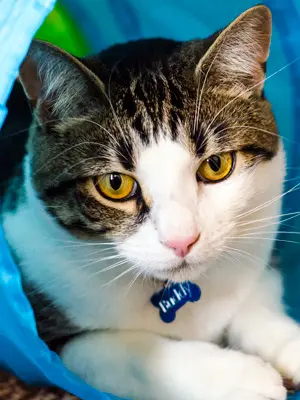Daily Monitoring of Communal Cat Rooms

Daily monitoring is essential because it helps you focus on the compatibility of cats in the group and lets you quickly identify problems and make adjustments for the welfare of all of the cats.
Identifying Each Cat
This is your first step since without clear identification it’s almost impossible to monitor your room appropriately and take corrective action. So whether your system is high-tech or low-tech, it is important to have a way to distinguish the various residents. Options include:
- Implanted microchips
- Collar tags
- Color-coded collars
- Labeled photographs (if you have a smaller number of communal cats)
What to Watch For
You’ll want to be on the lookout for any overly hostile, aggressive, or guarding behaviors, and make sure each cat has unimpeded access to food, water, a litter box, bedding, and some personal space.
Weigh each cat on a weekly basis during his or her stay in the shelter to monitor weight loss or gain – and remember that weight loss can be an early indicator of stress and failure to thrive in a group cat setting.
Just as important – but more complicated – is continuous monitoring of the cats for signs of acute or unrelieved stress. This can be a difficult task, because:
- Stress signs can be subtle
- Signs can involve behavior that is active or passive; passive responders may appear to be resting when they are actually immobilized by stress
- The difference between normal, desirable behavior and that which is indicative of stress may amount to a matter of degree – hiding, for example, is a natural feline behavior; excessive hiding is a symptom of stress
Print this poster and put it up in your communal cat room to remind all staff and volunteers what to watch for.
Active Indicators of Stress
- Avoidance
- Lowered posture
- Spraying
- Eliminating outside of the litter box
- Aggression
- Stereotypic behavior (e.g. over-grooming, pacing, fabric eating, or head-bobbing)
- Hiding without interacting with caretakers or other cats
- Using the litter box as a bed or retreat space
Passive Indicators of Stress
- Reduced activity or mobility
- Reduced maintenance behavior (e.g. grooming, sleeping, or eating)
- Passivity or withdrawal (e.g. staying in corners or turning away from the group)
- Unresponsiveness
- Weight loss
Steps to Take for Chronic or Severe Stress
- Remove the cat from the room or remove other cats who may be causing problems.
- Perform a medical examination to ensure the cat is otherwise healthy.
- Confirm that the room is properly equipped and arranged to provide each cat with access to bedding, food, water, a litter box, hiding/resting places, perches, and sources of stimulation (jumping and climbing opportunities such as catwalks, ramps, steps, and surfaces for scratching).
- Look for and eliminate potential stressors (unfamiliar caretakers, inconsistent handling, or changes to the accustomed environment).
- The removed cat, if known to be a good candidate for group living, can potentially be placed in a different group – but take care to avoid repetitive replacement in groups because each new environment is a source of new stress.
- For some cats, an individual cat condo will be the least stressful alternative.
